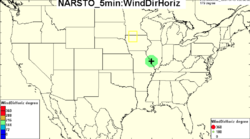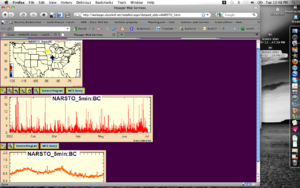Difference between revisions of "NARSTO 5min"
| (7 intermediate revisions by 2 users not shown) | |||
| Line 1: | Line 1: | ||
| + | '''For NARSTO Telecon - See [http://datafedwiki.wustl.edu/index.php/2009-12-03:_Create_standard_interface_to_NARSTO_STL_Supersite_data 2009-12-03: Create standard interface to NARSTO STL Supersite data]''' | ||
| + | |||
{{Dataset | {{Dataset | ||
|DatasetTitle=NARSTO EPA_SS_ST_LOUIS Air Chemistry, Particulate Matter, and Meteorological Data | |DatasetTitle=NARSTO EPA_SS_ST_LOUIS Air Chemistry, Particulate Matter, and Meteorological Data | ||
| − | |DatasetDesc=The overall goal of the St. Louis - Midwest Supersite was to conduct aerosol physical and chemical measurements needed by the health effects community, the atmospheric science community and the regulatory community to properly assess the impact of particulate matter exposure on human health and to develop control strategies to mitigate these effects. | + | |DatasetDesc=The overall goal of the St. Louis - Midwest Supersite was to conduct aerosol physical and chemical measurements needed by the health effects community, the atmospheric science community and the regulatory community to properly assess the impact of particulate matter exposure on human health and to develop control strategies to mitigate these effects. |
| + | |Parameters=RH, T1, T2, TVD, UVC, WindDirHoriz | ||
|Domain=Aerosol | |Domain=Aerosol | ||
|SamplePlatform=Network | |SamplePlatform=Network | ||
|SampleMethod=Point | |SampleMethod=Point | ||
|DataType=POINT | |DataType=POINT | ||
| + | |GeoRange=US | ||
| + | |TimePeriod=HIST | ||
|ProviderAbbr=NARSTO | |ProviderAbbr=NARSTO | ||
|ProviderURL=http://cdiac.esd.ornl.gov/programs/NARSTO/ | |ProviderURL=http://cdiac.esd.ornl.gov/programs/NARSTO/ | ||
|DataAccessURL=ftp://narsto.esd.ornl.gov/pub/EPA_Supersites/stl/AIR_CHEM_PM_MET/ | |DataAccessURL=ftp://narsto.esd.ornl.gov/pub/EPA_Supersites/stl/AIR_CHEM_PM_MET/ | ||
| + | |DataFedViewer=http://webapps.datafed.net/datafed.aspx?dataset_abbr=NARSTO_5min | ||
| + | |DatasetAbbr=NARSTO_5min | ||
| + | |GoogleEarthURL=http://webapps.datafed.net/loop.wsfl?init=cgi.wsfl%3fview_state%3dconsoles%252fpnt_hdr%26dataset_abbr%3dNARSTO_5min%26param_abbr%3dWindDirHoriz%26name%3dNARSTO_5min.WindDirHoriz%252b2001-07-07T05%25253a00%25253a00%252b-%252b2001-07-07T05%25253a00%25253a00%26export_filename%3dNARSTO_5min.WindDirHoriz.kmz%26export_format%3dkmz&calc=cgi.wsfl%3fdataset_abbr%3dNARSTO_5min%26view_id%3dmap%26export_type%3dpoint%26ignore_cache%3dtrue&accu=kml_merge_timeseries.wsfl&done=mark_kml_header.wsfl%3fbacklink%3dhttp%253a%252f%252fwebapps.datafed.net%252fge.aspx%253fdataset_abbr%253dNARSTO_5min%2526view_id%253dmap%2526param_abbr%253dWindDirHoriz%2526kml_header%253dhttp%25253a%25252f%25252fwebapps.datafed.net%25252fviews%25252fconsoles%25252fpnt_hdr.xml%2526pr%253dstatic%2526time_min%253d2001-07-07T05%25253a00%25253a00%2526time_max%253d2001-07-07T05%25253a00%25253a00%2526time_step%253dPT5M%2526kmz_file%253d%26action%3dnone%26cursor_visible%3dtrue%26dataset_abbr%3dNARSTO_5min%26days_of_week_filter%3dMon%2bTue%2bWed%2bThu%2bFri%2bSat%2bSun%26height%3d150%26hours_of_day_filter%3d0%2b1%2b2%2b3%2b4%2b5%2b6%2b7%2b8%2b9%2b10%2b11%2b12%2b13%2b14%2b15%2b16%2b17%2b18%2b19%2b20%2b21%2b22%2b23%26julian_after%3d5%26julian_before%3d-5%26julian_on%3doff%26lat%3d43.24%26lat_cursor_size%3d2%26lat_max%3d50%26lat_min%3d24%26loc_code%3dES2SUSILESL_%26lon%3d-94.67%26lon_cursor_size%3d2%26lon_max%3d-66%26lon_min%3d-127%26margins%3dtrue%26months_filter%3dTTT-TTT-TTT-TTT%26num_levels%3d6%26param_abbr%3dWindDirHoriz%26scale_max%3d360%26scale_min%3d0%26scale_mode%3dlinear%26symbol_height%3d15%26symbol_width%3d15%26view_scale%3d1%26width%3d300&pr=static&time_range=2001-07-07T05:00:00&dataset_abbr=NARSTO_5min&view_id=map&height=150&lat_max=50&lat_min=24&lon_max=-66&lon_min=-127&margins=true¶m_abbr=WindDirHoriz&width=300&name=NARSTO_5min.WindDirHoriz+2001-07-07T05%3a00%3a00+-+2001-07-07T05%3a00%3a00&ovl_name=NARSTO_5min.WindDirHoriz:%20$(datetime) | ||
}} | }} | ||
| + | == Data == | ||
| + | |||
| + | |||
| + | [[Image:NARStO_5Min.png|300px]] | ||
| + | |||
| + | [http://datafedwiki.wustl.edu/index.php/NARSTO For a list of columns that have been ingested] | ||
| + | |||
==Metadata == | ==Metadata == | ||
* [http://datafedwiki.wustl.edu/images/3/3c/Aqcommcat_discovery_fields_NARSTOmap.xls AQ Community Catalog Record/NARSTO Crosswalk Spreadsheet] | * [http://datafedwiki.wustl.edu/images/3/3c/Aqcommcat_discovery_fields_NARSTOmap.xls AQ Community Catalog Record/NARSTO Crosswalk Spreadsheet] | ||
* [http://capita.wustl.edu/DataspaceMetadata_trial/NARSTO.EPA_SS_ST_Louis.CarbonBlack.xml NARSTO.EPA_SS_ST_Louis.CarbonBlack Metadata Record] | * [http://capita.wustl.edu/DataspaceMetadata_trial/NARSTO.EPA_SS_ST_Louis.CarbonBlack.xml NARSTO.EPA_SS_ST_Louis.CarbonBlack Metadata Record] | ||
| − | * [http://wiki.esipfed.org/index.php/ | + | * [http://wiki.esipfed.org/index.php/NARSTO_5min DataSpace for EPA_SS_ST_Louis] |
=== Issues with metadata === | === Issues with metadata === | ||
| Line 54: | Line 69: | ||
<Keywords><![CDATA[Magee Scientific Aethalometer]]></Keywords> | <Keywords><![CDATA[Magee Scientific Aethalometer]]></Keywords> | ||
<Keywords><![CDATA[Carbon: black]]></Keywords> | <Keywords><![CDATA[Carbon: black]]></Keywords> | ||
| − | |||
| − | |||
| − | |||
== Links == | == Links == | ||
Latest revision as of 12:36, December 15, 2009
For NARSTO Telecon - See 2009-12-03: Create standard interface to NARSTO STL Supersite data
NARSTO_5min - NARSTO EPA_SS_ST_LOUIS Air Chemistry, Particulate Matter, and Meteorological Data
 |
Description: The overall goal of the St. Louis - Midwest Supersite was to conduct aerosol physical and chemical measurements needed by the health effects community, the atmospheric science community and the regulatory community to properly assess the impact of particulate matter exposure on human health and to develop control strategies to mitigate these effects. Parameters: RH, T1, T2, TVD, UVC, WindDirHoriz |
NARSTO |
- Browse Fields
- RDF for NARSTO_5min <- Should be a property
- What Links here on ESIP wiki
- 400px
Data
For a list of columns that have been ingested
Metadata
- AQ Community Catalog Record/NARSTO Crosswalk Spreadsheet
- NARSTO.EPA_SS_ST_Louis.CarbonBlack Metadata Record
- DataSpace for EPA_SS_ST_Louis
Issues with metadata
- Naming convention for the dataset name and param name
- Dataset description from original metadata too long?
- For this dataset the dataset point of contact are people (i.e. the scientist) not an organization. Do we modify the template for a person?
- Original metadata includes parameter description, other keywords for topic, describes the instrument and time res.
- for our Parameter keyword - I used their parameter keyword
- for Instrument - I used their sensor field in parameter description
- for domain - they had an aerosol in topic for the parameter description
- For temporal resolution - they had temporal resolution
- NARSTO includes project and other keywords that we do not currently include such as: the site id and address, brand of instrument, PM2.5, semi-continuous BC, UV
<Project><![CDATA[EPA Supersites--St. Louis]]></Project> <Site_Information> <Site><![CDATA[EPA SS St. Louis]]></Site> <Westernmost_Longitude><![CDATA[-90.1603]]></Westernmost_Longitude> <Easternmost_Longitude><![CDATA[-90.1603]]></Easternmost_Longitude> <Northernmost_Latitude><![CDATA[38.6122]]></Northernmost_Latitude> <Southernmost_Latitude><![CDATA[38.6122]]></Southernmost_Latitude> </Site_Information> <Time_Period> <Temporal_Coverage> <Start_Date><![CDATA[20010411]]></Start_Date> <End_Date><![CDATA[20030720]]></End_Date> </Temporal_Coverage> <Temporal_Resolution><![CDATA[5-Minute]]></Temporal_Resolution> </Time_Period> <Parameter_Description> <Topic><![CDATA[ATMOSPHERE]]></Topic> <Term><![CDATA[AEROSOLS]]></Term> <Parameter><![CDATA[CARBONACEOUS AEROSOLS]]></Parameter> <Sensor><![CDATA[AETHAELOMETER]]></Sensor> <Source><![CDATA[GROUND STATION]]></Source> </Parameter_Description> <Keywords><![CDATA[ES2SUSMOESL_]]></Keywords> <Keywords><![CDATA[13th and Tudor, East St. Louis, IL]]></Keywords> <Keywords><![CDATA[PM-2.5 ]]></Keywords> <Keywords><![CDATA[Semicontinuous BC and UV-C]]></Keywords> <Keywords><![CDATA[Magee Scientific Aethalometer]]></Keywords> <Keywords><![CDATA[Carbon: black]]></Keywords>
Links
- Google Scholar Papers for EPA Saint Louis 'Supersite'
- Links tagged in delicious with EPA_EE_SS_ST_Louis
Dataset Description
The overall goal of the St. Louis - Midwest Supersite was to conduct aerosol physical and chemical measurements needed by the health effects community, the atmospheric science community and the regulatory community to properly assess the impact of particulate matter exposure on human health and to develop control strategies to mitigate these effects. Metropolitan St. Louis is a major population center (2.5 million) well isolated from other urban centers of even moderate size, and is impacted by both distant and local sources. Local industry includes manufacturing,refining, and chemical plants. St. Louis is climatologically representative of the country’s eastern interior, affected by a wide range of synoptic weather patterns and free of localized influences from the Great Lakes, Ocean, Gulf, and mountains. It accordingly provides an ideal environment for studying the sources, transport, and properties of ambient particles.
Data Archive
Data files from all components of the St. Louis - Midwest Supersite program are archived in this single data set. Time-series plots are included for all of the numeric variables in each of the data files. These plots are useful for screening for outliers and visualization of values less than the detection limit and values with other quality flags. QA plans and the final St. Louis - Midwest Supersite report are included as documentation.
The initial data types archived include:
- 5-minute PM 2.5 black carbon (880 nm) and uv-absorbing carbon (370 nm) measured by a Magee Scientififc Aethalometer (Model AE-21).
- 1-hour PM 2.5 elemental carbon and blank-corrected organic carbon from semicontinuous thermo-optical analysis by the ACE-ASIA method.
- 24-hour PM 2.5 elemental carbon and organic carbon (both blank-corrected) from integrated filter with offline thermo-optical analysis by the ACE-ASIA method.
We expect to archive meteorological and additional PM data in the first half of 2009.
Program Objectives
- Implement and evaluate highly time-resolved particle measurement techniques.
- Characterize spatial and temporal (from minutes up to 24 hours) patterns of a large spectrum of particle physical and chemical properties in the St. Louis metropolitan area.
- Investigation of particle health effects.
Program Results
The scientific findings are reported in the EPA PM Supersite Final Report for the St. Louis - Midwest Supersite. The results have been organized around the three major objectives and include associated citations to papers from the research conducted within the program. This report is provided as a companion file [ STL-SS_FinalReport_Rev02_March2007.pdf ]. Ambient Particulate Matter Measurement Methods: This study provided numerous opportunities to evaluate emerging and recently-commercialized methods for measuring ambient aerosol chemical and physical properties.
Aerosol Climatology and Source-Receptor Relationships: The Supersite data set and allied data sets for the St. Louis metropolitan area have been used to elucidate spatial and temporal variability for several aerosol chemical and physical properties. These data are being used to: develop source/receptor models and determine source/receptor relationships for St. Louis; identify and examine the sources, formation processes and physical chemical properties of ambient particles; and support State Implementation Plan (SIP) development.
Data and Samples to Support Exposure and Health Effects Studies: The St. Louis Supersite data are being used to investigate relationships between air quality parameters and various health and toxicological endpoints. These projects are funded separate from the Supersites program but draw upon the St. Louis Supersite data (and in some cases the operations infrastructure) and thereby represent significant leveraging of investment in the St. Louis Supersite project.
The St. Louis - Midwest Supersite is one of several Supersites that was established in urban areas within the United States by the U.S. Environmental Protection Agency (EPA) to better understand the measurement, sources, and health effects of suspended particulate matter (PM).
The St. Louis - Midwest Supersite, in Metropolitan St. Louis (IL-MO), a major industrial and population center was a comprehensive research program that provided physical and chemical measurements needed by the health effects, atmospheric science and regulatory communities, in a setting broadly representative of the urban Midwest. The site is located at 13th and Tudor in East St. Louis (IL) approximately 3 km east of the City of St. Louis (MO) central business district, [Latitude 38.6122, Longitude -90.16028]. The site is primarily residential with some light commercial activities. A variety of transportation-related and industrial sources can impact this site as the emission fields are spatially heterogeneous.
The U.S. EPA Particulate Matter (PM) Supersites Program [1] was an ambient air monitoring research program from 1999-2004 designed to provide information of value to the atmospheric sciences, and human health and exposure research communities. Eight geographically diverse projects were chosen to specifically address these EPA research priorities: (1) to characterize PM, its constituents, precursors, co-pollutants, atmospheric transport, and its source categories that affect the PM in any region; (2) to address the research questions and scientific uncertainties about PM source-receptor and exposure-health effects relationships; and (3) to compare and evaluate different methods of characterizing PM including testing new and emerging measurement methods. Data collected by these projects are publicly available at the NARSTO Permanent Data Archive, NASA Langley DAAC. Data users should acknowledge the U.S. EPA Particulate Matter (PM) Supersites Program and the project investigator(s) listed below.
Acknowledgments
The St. Louis - Midwest Supersite commenced detailed measurements of ambient particulate matter (PM) in the St. Louis area in April 2001 with some measurements sustained through March 2005. This four-year measurement program was funded by various organizations. A cooperative agreement between USEPA OAQPS/ORD and Washington University established the foundation for the program (including infrastructure) and supported one year of measurements (April 2001 – May 2002). A grant through USEPA Region VII, with contributions from USEPA, Missouri DNR, CENRAP and LADCO/MRPO, permitted a majority of the initial measurement platform to be sustained through at least May 2003. Subsequently, LADCO/MPRO funded a skeletal suite of measurements through March 2005. Portions of the measurement program were also funded by the Electric Power Research Institute (EPRI).

